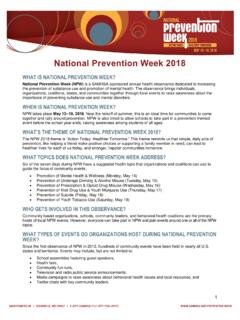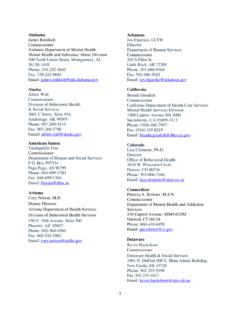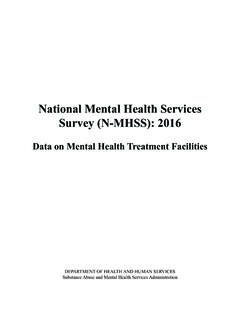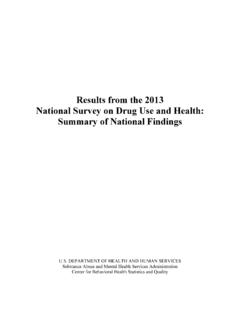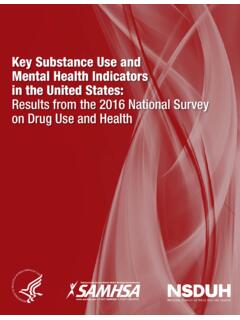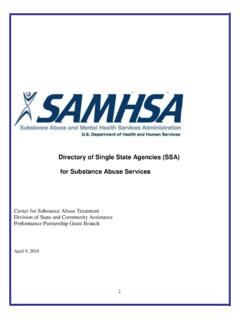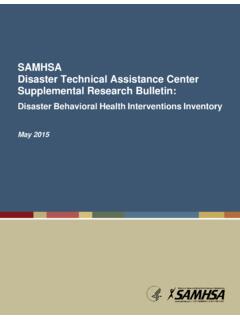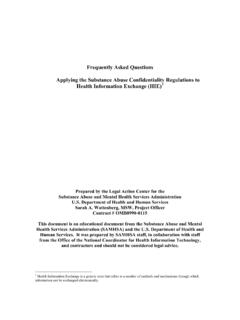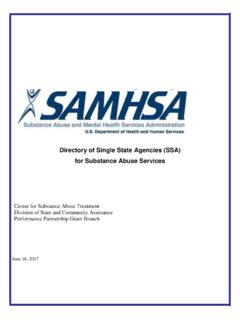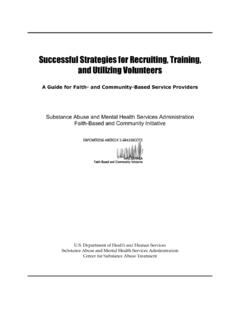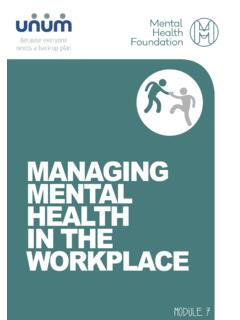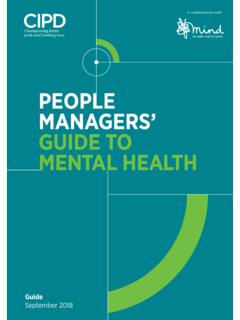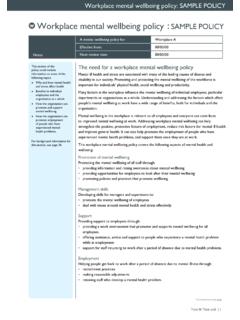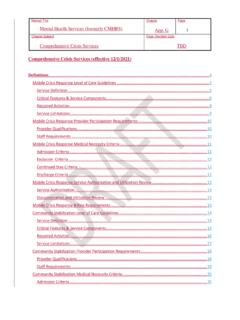Transcription of Medical Review Officer Manual - Substance Abuse and …
1 Department of health and Human services Substance Abuse and mental health services administration Center for Substance Abuse prevention Medical Review Officer Manual for Federal Agency workplace Drug Testing Programs EFFECTIVE OCTOBER 1, 2010 Note: This Manual applies to Federal agency drug testing programs that come under Executive Order 12564 dated September 15, 1986, section 503 of Public Law 100-71, 5 section 7301 note dated July 11, 1987, and the Department of health and Human services Mandatory Guidelines for Federal workplace Drug Testing Programs (73 FR 71858) dated November 25, 2008 (effective October 1, 2010). This Manual does not apply to specimens submitted for testing under Department of Transportation (DOT) Procedures for Transportation workplace Drug and Alcohol Testing Programs (49 CFR Part 40).
2 The current version of this Manual and other information including MRO Case Studies are available on the Drug Testing page under Medical Review Officer (MRO) Resources on the SAMHSA website: Previous Versions of this Manual are Obsolete 3 Table of Contents Chapter 1. The Medical Review Officer (MRO).. 6 Chapter 2. The Federal Drug Testing Custody and Control 7 Chapter 3. Urine Drug 9 A. Federal workplace Drug Testing 9 B. Test 13 C. Drug 14 D. Adulterant 24 E. 27 Chapter 4. The MRO Review and Reporting 28 A. Administrative Review of 28 B. Donor 38 C. Refusal to 39 D. Split Specimen 40 E. Interpretation and Result 41 F. 53 Chapter 5.
3 Documentation and 54 Chapter 6. Additional MRO 55 A. Federal Agency Blind 55 B. Insufficient 57 C. Occupational and Public 59 D. Donor Rights to 59 Appendix A. Specimen Reporting 61 Appendix B. 65 Appendix C. IITF Transfer to Laboratory Supplemental Custody and Control 69 Table 1. 71 Table 2. Some Specimen Validity Test 72 Table 3. Some Substances that Metabolize to 75 Table 5. MRO Actions for Primary Specimen Reports (Bottle A).. 80 4 Table 6. MRO Actions for Split Specimen Reports (Bottle B).. 82 85 Additional References (examples):.. 86 5 Chapter 1. The Medical Review Officer (MRO) The final Review of results is an essential component of any drug testing program.
4 A positive laboratory test result does not automatically identify an employee or job applicant as an illegal drug user, nor does a laboratory result of invalid, substituted, or adulterated automatically identify specimen tampering. An individual with a detailed knowledge of possible alternative Medical explanations must interpret drug test results in the context of information obtained from the donor interview. The Department of health and Human services (HHS) requires the Medical Review Officer (MRO) to fulfill this important function. The HHS Mandatory Guidelines for Federal workplace Drug Testing Programs (Mandatory Guidelines) define an MRO as a licensed physician holding either a Doctor of Medicine ( ) or Doctor of Osteopathy ( ) degree who has: Knowledge regarding the pharmacology and toxicology of illicit drugs; Training in the collection procedures used to collect Federal agency specimens; the interpretation of test results reported by laboratories; chain of custody, reporting, and recordkeeping requirements for Federal agency specimens; the HHS Mandatory Guidelines for Federal workplace Drug Testing Programs.
5 And procedures for interpretation, Review , and reporting of results as specified by the Federal agency or agencies for which the individual may serve as MRO; and Satisfactorily passed an examination administered by an HHS-approved organization ( , a nationally recognized entity that certifies MROs or a subspecialty board for physicians performing a Review of Federal employee drug test results). HHS publishes an annual list of approved organizations in the Federal Register. The MRO serves as the common point of contact between all participants in a drug test ( , the donor, the collector, the test facility, and the Federal agency s designated representative). The MRO may be an employee or a contractor for a Federal agency; however, the following restrictions apply: The MRO must not be an employee or agent of or have any financial interest in an instrumented initial test facility (IITF) or laboratory for which the MRO is reviewing drug test results, and The MRO must not derive any financial benefit by having an agency use a specific test facility or have any agreement with an IITF or laboratory that may be construed as a potential conflict of interest.
6 The purpose of these prohibitions is to prevent any arrangement between an IITF or laboratory and an MRO that could possibly influence the MRO and prevent him or her from reporting a problem identified with the test results or testing procedures. The MRO has the following responsibilities: Review all specimens reported as positive, adulterated, substituted, invalid, or rejected for testing, and report the verified result to the Federal agency; 6 Ensure that specimens reported as negative or as negative and dilute are properly reviewed ( , at least 5% personally and the remainder by staff under the MRO s direct, personal supervision) and reported to the Federal agency; Review the results of all Federal agency blind samples and perform the initial investigation into discrepant results.
7 Discuss potential invalid results with the laboratory to determine whether further testing at another HHS-certified laboratory is warranted; Conduct or facilitate a Medical evaluation of the donor when a collector reports that the donor was unable to provide a urine specimen; Perform an initial investigation of problems identified in the drug testing process and notify the appropriate regulatory authority of findings; Monitor the frequency of errors and notify responsible parties to take corrective action to prevent recurrence; and Maintain records and confidentiality of drug test information. HHS recommends that each MRO use the information contained in this Manual to ensure consistency and to improve the overall quality of the MRO Review process.
8 Chapter 2. The Federal Drug Testing Custody and Control Form Federal agencies are required to use the Office of Management and Budget (OMB)-approved Federal Custody and Control Form (CCF) for their agency workplace drug testing programs. The following are examples of employers prohibited from using the Federal CCF: Private-sector employee drug testing programs, other than testing conducted under the Department of Transportation (DOT) regulations State workplace drug testing programs Department of Justice drug testing programs The Federal CCF is usually provided by the IITF or laboratory that will test the specimen and is also available from other sources ( , forms suppliers, collectors, third party administrators, MROs).
9 The 2010 Federal CCF has an effective date of October 1, 2010. The 2000 Federal CCF was published in the Federal Register on June 23, 2000 (65 FR 39155), with an effective date of August 1, 2000. To allow for depletion of existing supplies of the 2000 Federal CCF, OMB permitted the use of this Federal CCF in Federal workplace drug testing programs through September 30, 2011. Therefore, for one (1) year after the implementation of the revised 2010 Federal CCF on October 1, 2010, regulated specimens may be collected, 7tested, and reported using the 2000 Federal CCF. From October 1, 2010 through September 30, 2011, Federal agencies may use either Federal CCF for their workplace drug testing programs.
10 However, because the two forms differ, the laboratory reporting the primary specimen may need to add additional information to the 2000 Federal CCF as described in Chapter 4, Section A, Administrative Review of Documents see Item 6: Use of the 2000 Federal CCF. As of October 1, 2011, the 2010 Federal CCF will be the only Federal CCF for regulated specimens. If a regulated specimen is received at a test facility with the 2000 Federal CCF after September 30, 2011, the test facility (IITF or laboratory) must treat this as a correctable discrepancy as described in Chapter 4, Section A, Administrative Review of Documents see Item 5(b): Actions Based on Administrative Review . Links to both the 2010 Federal CCF and the 2000 Federal CCF are on the SAMHSA website Federal CCF Description (2010 Federal CCF and 2000 Federal CCF) Both are five-part forms and the function of each copy is the same: Copy 1 Test Facility Copy sent to the IITF or laboratory with the specimen bottles Copy 2 - MRO Copy sent to the MRO Copy 3 - Collector Copy retained by the collector Copy 4 - Employer Copy sent to the Federal agency Copy 5 - Donor Copy given to the donor when the collection process is complete Each Federal CCF is printed with a unique specimen identification (ID) number.
